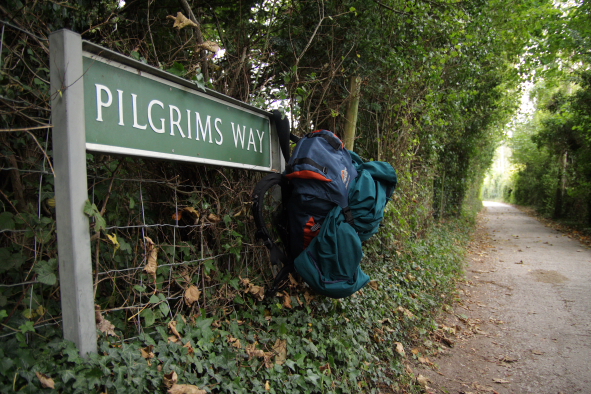I had wanted to hike the Pilgrim’s Way for many years. I had walked sections of it before but wanted to commit to something longer and, hopefully, more prayerful. I had vague recollections of the Canterbury Tales from English lessons and liked the idea of long days of walking followed by evenings beside a roaring fire.
My first day’s hike was a mere nine miles. Walking along green lanes, spotting buzzards and a dormouse, I imagined myself alongside one of Chaucer’s characters. But the ever-present sound of the M2 and the passing Eurostar reminded me that much has changed. I was making for the Carmelites at Aylesford where I was spending the night. This peaceful Friary, built of flint and thatch, nestles in a bend of the Medway. I arrived in time for evening prayer, a hot bath and some simple food.
 After a Eucharist the next morning, I set out eastwards along the North Downs Way. Chaucer’s pilgrims may well have followed the route of today’s A2 and the ‘Pilgrim’s Way’ marked on our maps owes more to Victorian romanticism than medieval archaeology. Nevertheless the views south from the downs, are a great backdrop for prayer. Eventually, as dusk fell and after seventeen miles, I arrived at The Oak at Charing. Achey and sweaty I stumbled into the bar to be greeted by curious stares.
After a Eucharist the next morning, I set out eastwards along the North Downs Way. Chaucer’s pilgrims may well have followed the route of today’s A2 and the ‘Pilgrim’s Way’ marked on our maps owes more to Victorian romanticism than medieval archaeology. Nevertheless the views south from the downs, are a great backdrop for prayer. Eventually, as dusk fell and after seventeen miles, I arrived at The Oak at Charing. Achey and sweaty I stumbled into the bar to be greeted by curious stares.  My final day’s walk brought blue skies, skylarks and yellowing poplars. Unfortunately, I also had another seventeen miles ahead of me. As I turned north-east at Boughton Lees, however, I had a sense of being on the last leg.
My final day’s walk brought blue skies, skylarks and yellowing poplars. Unfortunately, I also had another seventeen miles ahead of me. As I turned north-east at Boughton Lees, however, I had a sense of being on the last leg. Walking through King’s Wood, south of Chilham I met a mountain biker who asked me what it was in aid of? I tried to explain that I wasn’t raising money but going on a pilgrimage. Finally, I arrived in Canterbury and made my way to the Franciscan Friary for a hot bath, a meal with pudding (as it was a saints day) and prayers for a peaceful night which were duly answered.
The next morning I headed for the Cathedral and spent time praying in the ancient crypt. It was here that Thomas a Becket’s body was first laid to rest after he was killed by four of Henry II’s knights. It was this martyrdom and the miracles that followed which made Canterbury one of the most important centres of pilgrimage across Europe.
 For medieval pilgrims the journey promised indulgences. For me the benefits were less exalted; an opportunity for walking, the appreciation of nature, a chance to pray and reflect and meet some interesting people.
For medieval pilgrims the journey promised indulgences. For me the benefits were less exalted; an opportunity for walking, the appreciation of nature, a chance to pray and reflect and meet some interesting people. And maybe the sight of a priest walking an ancient pathway, might just have reminded people that pilgrims still exist.

No comments:
Post a Comment